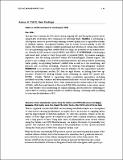Por favor, use este identificador para citar o enlazar a este item:
http://hdl.handle.net/10261/191519COMPARTIR / EXPORTAR:
 SHARE
BASE SHARE
BASE
|
|
| Visualizar otros formatos: MARC | Dublin Core | RDF | ORE | MODS | METS | DIDL | DATACITE | |

| Campo DC | Valor | Lengua/Idioma |
|---|---|---|
| dc.contributor.author | Sampedro, Nagore | - |
| dc.contributor.author | Arin, Laura | - |
| dc.contributor.author | Vila, Magda | - |
| dc.contributor.author | Garcés, Esther | - |
| dc.contributor.author | Reñé, Albert | - |
| dc.contributor.author | Camp, Jordi | - |
| dc.date.accessioned | 2019-09-25T09:10:47Z | - |
| dc.date.available | 2019-09-25T09:10:47Z | - |
| dc.date.issued | 2018-04-25 | - |
| dc.identifier.citation | ICES. 2018. Interim Report of the ICES - IOC Working Group on Harmful Algal Bloom Dynamics (WGHABD): 43-44 (2018) | - |
| dc.identifier.citation | ICES-IOC WGHABD Report 2018 : Ecosystem Processes and Dynamics Steering Group : ICES CM 2018/EPDSG:11 : Ref. SCICOM: 43-44 (2018) | - |
| dc.identifier.uri | http://hdl.handle.net/10261/191519 | - |
| dc.description | ICES - IOC Working Group on Harmful Algal Bloom Dynamics (WGHABD), 24-28 April 2018, Tarragona, Spain.-- 2 pages | - |
| dc.description.abstract | There is a general concern that HABs are increasing worldwide maybe as a consequence of some factors favoring proliferations or maybe due to an increase of sampling efforts and the improvement of detection methods. To solve this question, studies on the dy-namics of these algal species are required in places with a similar frequency sampling over a long period of time. Using time series of phytoplankton from several stations along the Catalan coast (NW Mediterranean), we analyze the trends of potentially toxic species. The objective was to determine if the proliferations of toxic species increased during the study period (2000-2012) along the Catalan coast.While the blooms of potentially PSP producer species, increased in general in many of the confined stations studied, due to the increase of A. minutum, the A. pacificum were not more detected in most of the stations during the last years of the study period. The blooms of DSP producer species did not shown an increase but there was also a clear increase in the number of blooms of the genus Pseudo-nitzschia (genus with species potentially producing ASP toxicity) as a consequence of the increasing abundances in most of the confined stations | - |
| dc.publisher | International Council for the Exploration of the Sea | - |
| dc.relation.ispartofseries | ICES CM 2018/EPDSG:11 | - |
| dc.rights | openAccess | - |
| dc.title | Dynamics of toxic phytoplankton species along the Catalan coast (NW Mediterranean Sea) | - |
| dc.type | informe técnico | - |
| dc.relation.publisherversion | http://www.ices.dk/sites/pub/Publication%20Reports/Expert%20Group%20Report/EPDSG/2018/01%20WGHABD%20-%20Report%20of%20the%20ICES-IOC%20Working%20Group%20on%20Harmful%20Algal%20Bloom%20Dynamics.pdf | - |
| dc.date.updated | 2019-09-25T09:10:47Z | - |
| dc.description.version | Peer Reviewed | - |
| dc.language.rfc3066 | eng | - |
| dc.relation.csic | Sí | - |
| dc.type.coar | http://purl.org/coar/resource_type/c_18gh | es_ES |
| item.openairecristype | http://purl.org/coar/resource_type/c_18cf | - |
| item.fulltext | With Fulltext | - |
| item.cerifentitytype | Publications | - |
| item.openairetype | informe técnico | - |
| item.grantfulltext | open | - |
| Aparece en las colecciones: | (ICM) Informes y documentos de trabajo | |
Ficheros en este ítem:
| Fichero | Descripción | Tamaño | Formato | |
|---|---|---|---|---|
| Sampedro_et_al_2018.pdf | 112,77 kB | Adobe PDF |  Visualizar/Abrir |
CORE Recommender
Page view(s)
266
checked on 18-abr-2024
Download(s)
69
checked on 18-abr-2024
Google ScholarTM
Check
NOTA: Los ítems de Digital.CSIC están protegidos por copyright, con todos los derechos reservados, a menos que se indique lo contrario.
